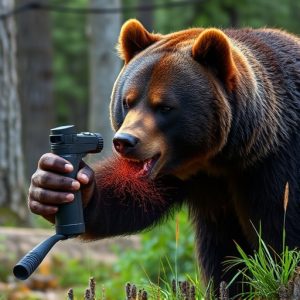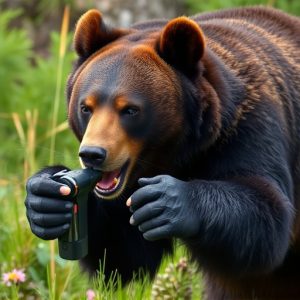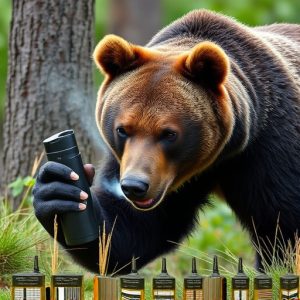Bear Spray Fog Pattern Test: Effectiveness & Best Use Strategies
The Bear Spray Fog Pattern Test is a crucial evaluation for understanding bear spray effectiveness i…….
The Bear Spray Fog Pattern Test is a crucial evaluation for understanding bear spray effectiveness in real-world scenarios, focusing on range, density, and dispersion of the fog. The goal is a dense, lingering fog covering the threat zone, offering maximum protection time against aggressive bears. Key factors include creating a sensory obstruction and maintaining high concentration within 25 feet (7.6 meters). Bear spray, using capsaicin-laden droplets, temporarily disorients and irritates bears, prompting retreat. Correct usage involves aiming at the bear's face and eyes from 2-3 meters (6-10 feet), providing escape time. Regular training is essential for survival rates; it surpasses noise makers and pepper spray with broader protection.
“Uncovering the effectiveness of bear spray in defending against aggressive bears is a crucial aspect of wilderness safety. This article delves into the science behind bear spray, focusing on the Bear Spray Fog Pattern Test—a key indicator of its performance. We explore factors influencing its efficacy, including weather conditions and distance, and how the spray’s dispersion offers protection. Additionally, we analyze real-world use cases, compare it with other deterrents, and provide insights for responsible usage.”
- Understanding Bear Spray Fog Pattern Test
- Factors Influencing Bear Spray Effectiveness
- How Bear Spray Disperses and Protects
- Effective Use Cases of Bear Spray During Confrontations
- Comparison with Other Bear Deterrents
Understanding Bear Spray Fog Pattern Test
Understanding Bear Spray Fog Pattern Test is crucial when assessing its effectiveness against charging bears. This test simulates real-world scenarios by measuring the spray’s range, density, and dispersion pattern. It involves releasing a controlled amount of bear spray into the air to observe how it spreads, ensuring every part of the potential threat zone is covered.
The Bear Spray Fog Pattern Test provides valuable insights into the spray’s performance. A well-designed test should result in a dense fog that lingers, allowing for maximum protection time. This ensures that when faced with an aggressive bear, the spray can effectively disrupt its behavior and provide a crucial escape window.
Factors Influencing Bear Spray Effectiveness
The effectiveness of bear spray against charging bears depends on several key factors. One crucial aspect is the spray’s fog pattern, which plays a significant role in ensuring maximum coverage. A successful Bear Spray Fog Pattern Test reveals that an effective spray should create a dense, even cloud of aerosol, effectively obscuring the bear’s vision and sensory perception. This allows the individual to create distance from the bear, which can be life-saving in dangerous encounters.
Additionally, the proximity of the bear at the time of application is critical. Bear spray works best when the user is within close range, typically up to 25 feet (7.6 meters), of the charging bear. Beyond this range, the spray’s effectiveness decreases significantly due to reduced concentration and potential drift from wind or environmental factors. Understanding these variables helps in strategic deployment of bear spray during potential encounters, ensuring its potency when needed most.
How Bear Spray Disperses and Protects
Bear spray, also known as bear repellent, uses a unique fog pattern to protect individuals from aggressive bears. When deployed, the spray creates a dense cloud of fine droplets that quickly disperses in all directions. This rapid dispersion ensures that the chemicals reach the bear’s eyes, nose, and mouth, causing irritation and temporarily disorienting it. The Bear Spray Fog Pattern Test has shown that when used correctly, the fog can reach up to 30 feet, providing a buffer zone for escape or deterring an attack.
The fog pattern is designed to be non-lethal but highly effective in repelling bears. It’s crucial to spray directly towards the bear’s face and eyes for maximum impact. The active ingredients in bear spray, such as capsaicin (the main component in chili peppers), create a painful sensory overload that prompts the bear to retreat. This temporary distraction allows individuals to escape or seek shelter. Regular practice of the proper spraying technique, as demonstrated in various Bear Spray Fog Pattern Tests, is key to ensuring personal safety in bear country.
Effective Use Cases of Bear Spray During Confrontations
When faced with an aggressive bear, bearing spray can be a powerful tool for self-defense. The key to its effectiveness lies in understanding and executing proper usage techniques. One crucial aspect often studied is the bear spray fog pattern test, which evaluates how the spray disperses in various conditions. Research shows that when sprayed correctly, bear spray can create a barrier of capsaicin-laden fog, temporarily blinding and disorienting the bear. This gives the user precious time to retreat or, if necessary, fight back.
Effective use involves aiming for the bear’s face and eyes, as these areas are highly sensitive. The recommended distance for application is around 2-3 meters (6-10 feet), allowing for a direct hit without risking inhalation of the spray yourself. It’s important to remember that bear spray is not a guarantee of safety; it should be used as a last resort when all other escape routes are blocked. Regular training and familiarity with the product’s performance in different scenarios, including the fog pattern test results, can significantly enhance survival chances during bear encounters.
Comparison with Other Bear Deterrents
When comparing bear spray to other deterrents, like pepper spray or noise makers, tests have shown its unique advantages. The Bear Spray Fog Pattern Test has demonstrated that bear spray creates a dense, lingering cloud of capsicum oil, which can effectively stop an attacking bear by causing temporary blindness, coughing, and difficulty breathing. Unlike noise makers, which may startle bears but don’t always stop them, or pepper spray, which primarily targets the eyes, bear spray disrupts the animal’s entire sensory system.
Additionally, the fog pattern of bear spray allows for a wider reach, making it easier to deploy in situations where distance and speed are crucial factors. This distinct misting effect sets bear spray apart from other deterrents, increasing its reliability as a primary defense against charging bears.
In conclusion, understanding the bear spray fog pattern test and its influencing factors is key to ensuring its effectiveness during encounters. Bear spray, when used correctly, can disperse bears and provide valuable time for escape. Its unique dispersion method makes it a reliable deterrent, especially in situations where other methods may fail. By knowing the ideal usage scenarios and comparing it to other deterrents, individuals can make informed decisions to protect themselves in bear country.


